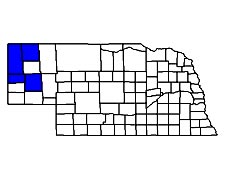
| Cicindela cinctipennis cinctipennis LeConte |
| Adult Length: 9 to 13 mm |
| Appearance: Adults are dark brown to blackish, often with a purplish to greenish sheen on the dorsal surface. The maculation normally consists of a complete marginal band that extends from the humeral to apical areas. The middle band is bent somewhat toward the posterior, and these is also a posthumeral and subapical marking present on each elytron. |
| Similar Species: This species might be confused with C. repanda or C. punctulata. Cicindela punctulata is never heavily marked, and C. repanda never has a marginal band that remains broad throughout its entire length. Cicindela repanda is also a much more bronze in color. |
| Biology: This species prefers moist saline and chalky alkaline clay soils, especially along the edge of grassy areas, and in somewhat grassy areas. It can be found on the edge of salt flats as well as in dry creek beds. Adults may fly when alarmed, or hide among grasses. |
| Adult Life History: Adults emerge from the pupa in June and July. Peak numbers in Nebraska probably occur mostly in late June. Numbers drop as the summer progresses, and adults are scarce by late-August. It is a summer species. |
| Larval Life History: The larval life history of this species is mostly unknown, but the larvae probably complete there life cycle in one or perhaps two years. The larvae probably occur in many of the same areas as the adults. |
| Biogeography: This species has only been collected in four counties in the western panhandle of Nebraska. In North America it occurs from central British Columbia and Alberta to southern Manitoba, central Kansas, northern Arizona, and southern California. There is still some disagreement on whether or not C. cinctipennis and C. terricola are the same species, but most recent authors consider them separate. The fact that both forms occur in the Nebraska panhandle with no apparent intergradation suggests that they are each distinct. There are at least two described subspecies. |

